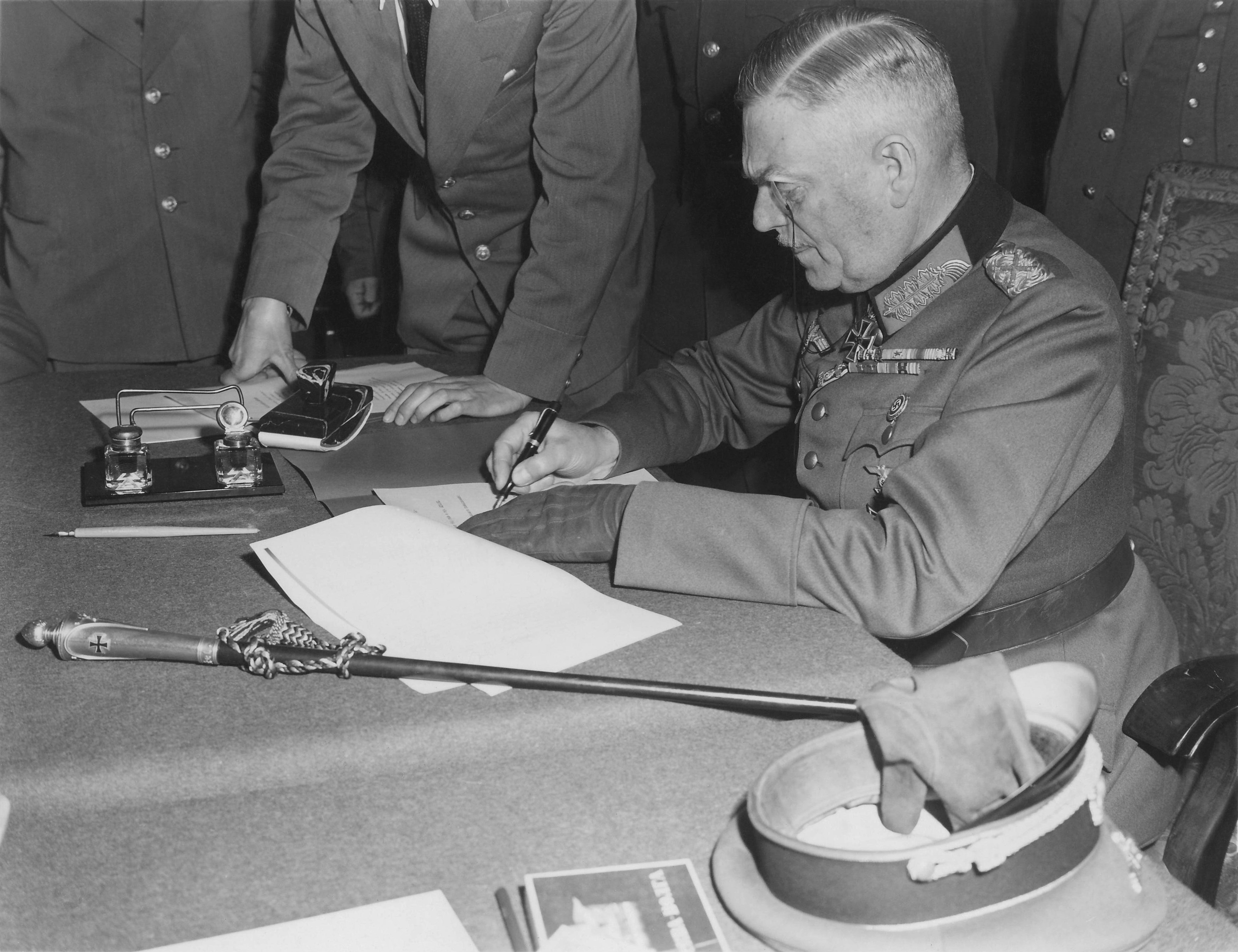
German Instrument of Surrender
The German Instrument of Surrender[a] was a legal document effecting the unconditional surrender of the remaining German armed forces to the Allies, and ended World War II in Europe; the signing took place at 22:43 CET on 8 May 1945[b] and the surrender took effect at 23:01 CET on the same day.
"Surrender of Germany" and "Capitulation of Germany" redirect here. For the armistice between the Weimar Republic of Germany and the Allied Powers that ended World War I, see Armistice of 11 November 1918.The capitulation of the German state to the conditions provided by the Allies
The day before that, Germany had signed another surrender document close to it with the Allies in Reims in France, but it was not recognized by the Soviet Union for enforcement, so another document was needed to sign; and in addition, immediately after signing the German forces were ordered to cease fire in the west and continue fighting in the east. Germany under the Flensburg Government led by the head of state, Grand-Admiral Karl Dönitz, also accepted the Allied suggestion to sign a new document. The document was signed at the seat of the Soviet Military Administration in Germany (Karlshorst, Berlin) by representatives from the German "Oberkommando der Wehrmacht" (OKW),[c] the Allied Expeditionary Force represented by the British, and the Supreme High Command of the Soviet Red Army, with further French and American representatives signing as the witnesses. This time, Field-Marshal Wilhelm Keitel was the highest representative of Germany at the signing ceremony. This surrender document of Germany also led to the de facto fall of Nazi Germany. As one result of Nazi German downfall, the Allies had de facto occupied Germany since the German defeat—which was later confirmed via the Berlin Declaration by the four countries of Allies as the common representative of new Germany (France, USSR, UK and the US), on 5 June 1945.
There were three language versions of the surrender document—English, Russian, and German—with the English and Russian versions proclaimed in the document itself as the only authoritative ones.
Background[edit]
On 30 April 1945, the head of state[d] of Germany Adolf Hitler killed himself inside his Führerbunker, under the Reich Chancellery,[1] having drawn up a testament in which Admiral Karl Dönitz succeeded him as next head of state of Germany, with the title of Reichspräsident.[2] But with the fall of Berlin two days later, and American and Soviet forces having linked up at Torgau on the Elbe, the area of Germany still under German military control had been split in two. Moreover, the speed of the final Allied advances of March 1945 – together with Hitler's insistent orders to stand and fight to the last – had left the bulk of surviving German forces in isolated pockets and occupied territories, mostly outside the boundaries of pre-Nazi Germany. Dönitz attempted to form a government at Flensburg on the Danish border, and was joined there on 2 May 1945 by the "Oberkommando der Wehrmacht" (OKW) (English: "High Command of the Armed Forces") under Wilhelm Keitel, which had previously relocated, first to Krampnitz near Potsdam, and then to Rheinsberg, during the Battle of Berlin. But, although Dönitz sought to present his government as 'unpolitical', there was no repudiation of Nazism, the Nazi Party was not banned, leading Nazis were not detained, and the symbols of Nazism remained in place. Both the Soviets and the Americans remained adamant in not recognizing Dönitz or the Flensburg Government as capable of representing the German state.
At Hitler's death, German armies remained in the Atlantic pockets of La Rochelle, St Nazaire, Lorient, Dunkirk and the Channel Islands; the Greek islands of Crete, Rhodes and the Dodecanese; most of Norway; Denmark; the northwestern Netherlands; northern Croatia; northern Italy; Austria; Bohemia and Moravia; the Courland peninsula in Latvia; the Hel Peninsula in Poland and in Germany towards Hamburg, facing British and Canadian forces; in Mecklenburg, Pomerania and the besieged city of Breslau, facing Soviet forces; and in southern Bavaria towards Berchtesgaden, facing American and French forces.[3]
"VE Day" and "Victory Day"[edit]
The Reims signing ceremony had been attended by considerable numbers of reporters, all of whom were bound by a 36-hour embargo against reporting the capitulation. As it became clear that there would need to be a definitive second signing before the Act of Surrender could become operative, Eisenhower agreed that the news blackout should remain; however, the American journalist Edward Kennedy of the Associated Press news agency in Paris broke the embargo on 7 May, with the consequence that the German surrender was headline news in the western media on 8 May.[31] Realizing that it had become politically impossible to keep to the original timetable, it was eventually agreed that the Western Allies would celebrate "Victory in Europe Day" on 8 May, but that western leaders would not make their formal proclamations of Victory until that evening (when the Berlin signing ceremony should be imminent). The Soviet government made no public acknowledgement of the Reims signing, which they did not recognize; Soviet Union celebrated "Victory Day" on 9 May 1945 because this document was signed when time was 9 May in Soviet Union. Today, both 8 May and 9 May are considered the end of World War II in Europe to celebrate due to time zone difference.